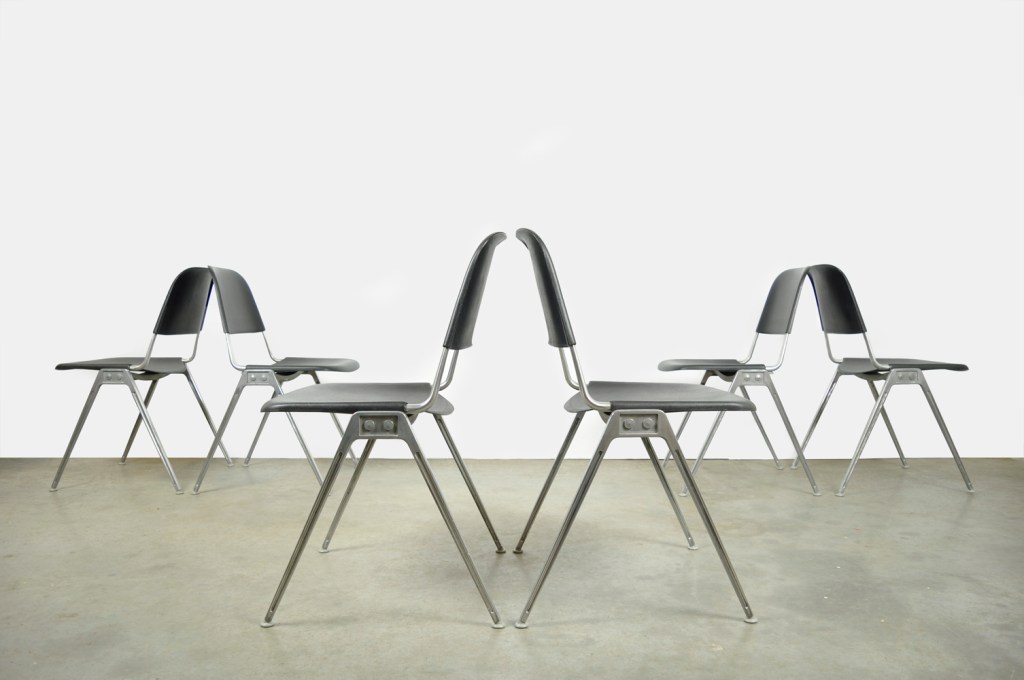SOLD (South Korea) /

Stackable dining chairs (6), model 1601, by Don Albinson for Knoll International, 1960s / stapelbare Knoll International design stoelen (6), model 1601, ontworpen door Don Albinson, 1960s. De stoelen hebben een frame van gegoten aluminium en zwarte kunststof zittingen. Elegante en comfortabele stoelen met kenmerkende passerpoten welke geinspireerd zijn op de ontwerpen van Jean Prouve en Friso Kramer.
De stoelen zijn gemerkt.
Conditie: goede vintage conditie. Lichte gebruikssporen op frame en zittingen overeenkomstig de leeftijd. Bij een poot ontbreekt een vloerdop.
Afmetingen: breed 50,5 cm, diep 54 cm, hoogte 81 cm, zithoogte 44 cm
Code: S2302
stackable Knoll International design chairs (6), model 1601, designed by Don Albinson, 1960s. The chairs have a cast aluminum frame and black plastic seats. Elegant and comfortable chairs with characteristic compass legs which are inspired by the designs of Jean Prouve and Friso Kramer.The chairs are marked. Good vintage condition. Light signs of wear on frame and seats according to age. One leg is missing a floor cap.














ORDER / CONTACT
Contactform
After receiving the form we will contact you as soon as possible. Thank you in advance, Derko-Jan
🟡 Dutch ART DECO beech chair by the firm Jac Levee NV, 1930s
Beautiful Art Deco armchair designed and manufactured by the Amsterdam firm Jac Levee NV around 1935. This beechwood armchair in the Amsterdam School style is a beautiful combination of traditional craftsmanship and modernist design principles. The black-painted round accents give the chair a distinctive character. The wicker seat provides comfortable seating. Original Art Deco / Amsterdam School design.
#artdeco #amsterdamschoolstyle #craftsmanship

🟡 JAPANESE ANTIQUES
A beautiful Japanese wooden mobile Tansu (箪笥) cabinet from the Meiji period, circa 1900, with a beautiful patina. The cabinet was primarily used for storing clothing, especially kimonos. This functional approach is clearly reflected in the metal corner protectors and the lockable drawers and sliding doors. This cabinet has several wide drawers, two sliding doors, and two “hidden” drawers behind a door. A nice detail is the cast iron supports on the sides of the cabinet. More interesting information about this characteristic piece of furniture with a rich history can be found on Wikipedia/Tansu, among other places. Beautiful cabinet in a modern interior or brutalist architecture.
On Hold
#tansu #japaneseantique #furniturehistory

🟡 REUSE FRIDAY
Buy timeless vintage design and make this Black Friday a little greener and more sustainable.
Buy what you need.
For beautiful, authentic, original furniture made with craftsmanship, you’ve come to the right place.
You can find our timeless beauties at www.degeleetalage.nl or @de_gele_etalage
#greenfriday #buyvintage #secondhand

🟡 PIRKKA
Iconic Scandinavian dining chairs, model Pirkka, designed by Finnish interior architect Ilmari Tapiovaara and manufactured by Laukaan Puu in the 1950s. The chairs (5 pieces) are made of high-quality pinewood and feature a beautiful brown finish and black lacquered legs. Beautiful craftsmanship with elegantly shaped components and solid mortise and tenon joints. Early edition and original marked mid-century set. A beautiful set together with the restored dining table.
#pirkka #scandinaviandesign #finnishdesign finnishvintage finnishmidcentury midcenturydesign interiordesign iconicvintage iconicdesign scandinavianvintage scandinavianmidcentury ilmaritapiovaara laukaanpuu chairs1950s craftmanship earlyedition interiorstyle scandinavianstyle bohostyle bohemianstyle stylishvintage timelessvintage degeleetalage vintyagedealer vintagenetherlands

🟡 Autumn light
All items available at www.degeleetalage.nl or sent a message.
Beautiful Rosewood sideboard by Leo Bub, Germany 1960s
Natural wooden side tables
Mid-century round rope mirror Adrien Audoux & Frida Minet, France 1960s
Buffalo leather armchair by Leolux, Netherlands 1970s
Small wooden bookshelf
Handmade (homemade) wooden bookcase 1970s
Wooden coffee table with inlaid ceramic tiles by Ebbe Sorensen, Denmark 1970s
Globe 2000 floorlamp by Frank Ligtelijn & Raak Amsterdam, Netherlands 1960s (sold)
Antique and primitive farm bench, 1900
Natural wooden brutalist vintage furniture with a warm character.
#leobub #rosewoodsideboard #raresideboard #treestumptable #adrienaudoux #fridaminet #ropemirror #midecenturyfurniture #brutalistfurniture #interiordesign #warminterior #brutalistinterior #buffaloleatherarmchair #leolux #70sarmchair #brutalistarmchair #woodenbookshelf #ceramictilestable #ebbesorensen #danishdesign #globe2000 #frankligtelijn #raak #vintagefloorlamp #vintagedealer #vintagedeventer #vintageamsterdam #worldwideshipping #newantiques






